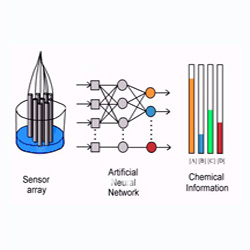A toolbox for chemical analysis

The thesis deals with a recent trend in the field of analysis, specifically the use of chemical sensors, such as electronic tongues. This concept addresses the problem of the lack of a specific response from the sensors, proposing the use sensor arrays with crossed response to various species and artificial intelligence tools to correct this. Electronic tongues are a bio-inspired concept, as they are based on the workings of the sense of taste. In animals, the mechanisms used to recognise tastes follow this concept, as they have a number of generic receptors (they can detect sweet, sour, bitter and salty) and recognition of species is carried out by a process that takes place in the brain. The proposed technique has various applications, both in the quantification of analytes and in the classification and identification of species, a mechanism analogous to the recognition of food in the sense of taste.
We need here, therefore, tools which allow us to elucidate the response generated by the sensor array. Besides this the system needs to be trained for the application which we need, in a process analogous to human learning. In a quantitative strategy, the artificial intelligence tools used are artificial neuronal networks, which in fact are based on the processes that take place in the brain itself. For quantitative analysis, the usual technique is an analysis of the main components in which maps or groupings of samples are obtained according to their similarity.
The thesis presents the design, construction and evaluation of electronic tongues for the classification of food samples, classifying mineral water according to its nature, orange juice according to orange content (an application which is not trivial in terms of its use in analytical laboratories) and the classification of infusions according to their flavour. Analogously we can say whether a substance is more or less salty, and electronic tongues have also been used for a quantitative determination of samples in environmental and industrial control and which allow us to quantify the target analytes, correcting for the presence of interfering species without needing to eliminate them. This enables a direct measurement strategy, where the complexity lies in the computer component, which is cheaper every day.
Electronic tongues therefore provide us with a whole range of possibilities and can be considered a toolbox for chemical analysis, which can be used in the environmental, food or clinical fields.
References
Thesis: "Llengües electròniques basades en sensors potenciomètrics", read by Jordi Gallardo Oña and directed dirigida per Manel del Valle Zafra.

